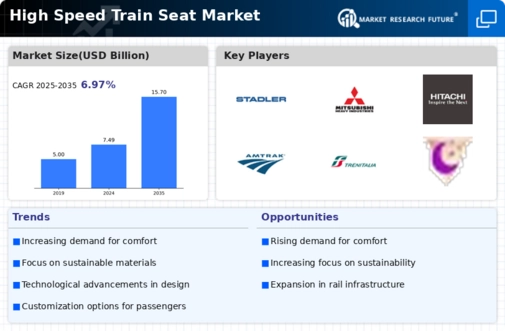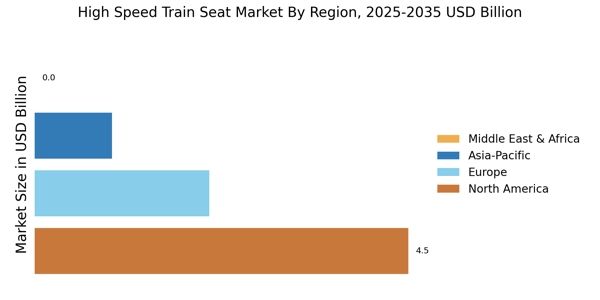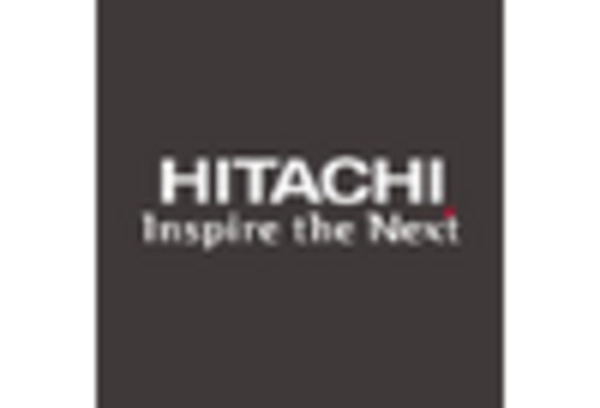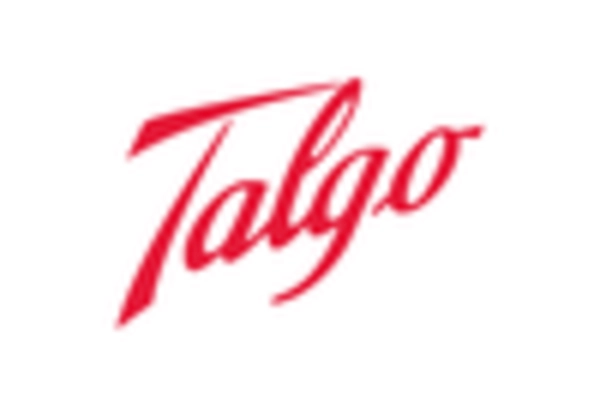Rising Environmental Awareness
Rising environmental awareness is a crucial driver for the High Speed Train Seat Market. As more individuals become conscious of their carbon footprints, there is a growing preference for sustainable travel options. High-speed trains are often viewed as an eco-friendly alternative to air travel, as they produce significantly lower emissions per passenger. This shift in consumer behavior is prompting rail operators to invest in more sustainable seating solutions, such as recyclable materials and energy-efficient manufacturing processes. Recent studies indicate that the demand for environmentally friendly travel options is expected to increase by 30% in the coming years. Consequently, the High Speed Train Seat Market is likely to see a surge in innovations aimed at reducing environmental impact, aligning with the broader trend of sustainability in transportation.
Technological Advancements in Seat Design
Technological advancements are significantly influencing the High Speed Train Seat Market. Innovations in materials and design are leading to the development of seats that offer enhanced comfort and safety features. For example, the integration of smart technologies, such as adjustable seating and built-in entertainment systems, is becoming increasingly common. Data suggests that the market for smart seating solutions is expected to grow by over 15% annually, reflecting the rising consumer preference for high-tech amenities. Additionally, advancements in lightweight materials contribute to overall train efficiency, as lighter seats can reduce the weight of the train, leading to lower energy consumption. As technology continues to evolve, the High Speed Train Seat Market is poised to adapt, offering passengers a more enjoyable and modern travel experience.
Growing Demand for Efficient Transportation
The High Speed Train Seat Market is experiencing a surge in demand due to the increasing need for efficient transportation solutions. As urbanization accelerates, more individuals seek alternatives to traditional commuting methods. High-speed trains offer a viable solution, significantly reducing travel time between major cities. According to recent data, the high-speed rail network is projected to expand by approximately 20% over the next five years, indicating a robust growth trajectory. This expansion necessitates the development of comfortable and ergonomic seating options to enhance passenger experience. Consequently, manufacturers are focusing on innovative designs and materials to meet the evolving expectations of travelers. The growing demand for efficient transportation is likely to drive investments in the High Speed Train Seat Market, fostering advancements in seat technology and comfort.
Increasing Competition Among Rail Operators
Increasing competition among rail operators is shaping the dynamics of the High Speed Train Seat Market. As more companies enter the high-speed rail sector, there is a heightened focus on enhancing passenger experience to attract customers. This competition drives innovation in seating design, as operators seek to differentiate themselves through superior comfort and amenities. Market data indicates that the number of high-speed rail operators is expected to double within the next decade, intensifying the race for market share. In response, manufacturers are compelled to develop cutting-edge seating solutions that cater to diverse passenger needs. This competitive landscape is likely to foster advancements in the High Speed Train Seat Market, as companies strive to offer the most appealing and comfortable travel experience.
Government Investments in Rail Infrastructure
Government investments in rail infrastructure are playing a pivotal role in the High Speed Train Seat Market. Many countries are prioritizing the development of high-speed rail networks as part of their transportation strategies. For instance, recent initiatives have allocated billions of dollars towards enhancing rail infrastructure, which includes upgrading existing lines and constructing new routes. This influx of funding is expected to stimulate the demand for high-speed train seats, as new trains will require modern seating solutions. Furthermore, the emphasis on sustainable transportation options aligns with the growing trend of high-speed rail, which is often viewed as a greener alternative to air travel. As governments continue to invest in rail infrastructure, the High Speed Train Seat Market is likely to benefit from increased production and innovation in seating designs.


















Leave a Comment